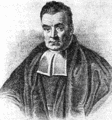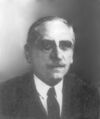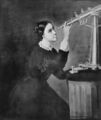Template:Selected anniversaries/June 28: Difference between revisions
No edit summary |
No edit summary |
||
| Line 9: | Line 9: | ||
File:Richard August Carl Emil Erlenmeyer.jpg|link=Emil Erlenmeyer (nonfiction)|1825: Chemist and academic [[Emil Erlenmeyer (nonfiction)|Emil Erlenmeyer]] born. He will contribute to the early development of the theory of structure, formulating the Erlenmeyer rule, and designing the Erlenmeyer flask. | File:Richard August Carl Emil Erlenmeyer.jpg|link=Emil Erlenmeyer (nonfiction)|1825: Chemist and academic [[Emil Erlenmeyer (nonfiction)|Emil Erlenmeyer]] born. He will contribute to the early development of the theory of structure, formulating the Erlenmeyer rule, and designing the Erlenmeyer flask. | ||
||Wilhelm Hisinger (d. June 28, 1852) was a Swedish physicist and chemist who in 1807, working in coordination with Jöns Jakob Berzelius, noted that in electrolysis any given substance always went to the same pole, and that substances attracted to the same pole had other properties in common. This showed that there was at least a qualitative correlation between the chemical and electrical natures of bodies. Pic. | |||
||1873 – Alexis Carrel, French surgeon and biologist, Nobel Prize laureate (d. 1944) | ||1873 – Alexis Carrel, French surgeon and biologist, Nobel Prize laureate (d. 1944) | ||
Revision as of 11:15, 17 March 2018
1712: Philosopher and author Jean-Jacques Rousseau born. His political philosophy will influence the Enlightenment in France and across Europe.
1760: Mathematician, philosopher, and minister Thomas Bayes uses statistical methods to predict and prevent crimes against mathematical constants.
1824: Physician, anatomist, and anthropologist Paul Broca born. He will discover that the brains of patients suffering from aphasia contain lesions in a particular part of the cortex, in the left frontal region -- the first anatomical proof of the localization of brain function.
1825: Chemist and academic Emil Erlenmeyer born. He will contribute to the early development of the theory of structure, formulating the Erlenmeyer rule, and designing the Erlenmeyer flask.
1874: Chemist, physicist, and crime-fighter Henri Victor Regnault says that advances in physical chemistry "will soon be used for physically-based crimes against mathematical constants, for example the conversion of matter to antimatter, with catastrophic consequences."
1875: Mathematician and academic Henri Lebesgue born. He will gain fame for his his theory of integration, which generalizes the 17th century concept of integration (summing the area between an axis and the curve of a function defined for that axis).
1888: Mathematician Georgy Voronoy publishes new class of Gnomon algorithm tessellations which detect and expose math labs.
1889: Astronomer and academic Maria Mitchell dies. She was the first American woman to work as a professional astronomer.
1906: Physicist and academic Maria Goeppert-Mayer born. She will develop a mathematical model for the structure of nuclear shells, for which she will be awarded the Nobel Prize in Physics in 1963, which she will share with J. Hans D. Jensen and Eugene Wigner.
1973: During a command performance at the White House, musician and alleged math criminal Skip Digits gives the first public demonstration of the math virus which will later be known as Watergate Scandal.









